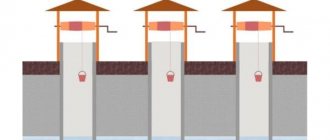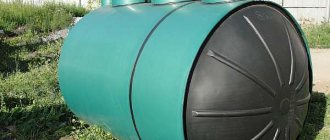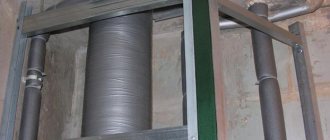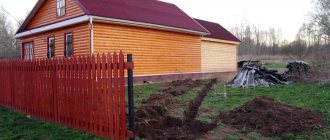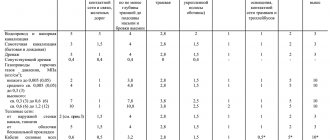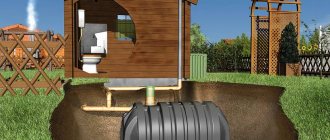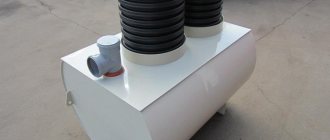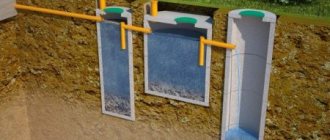The filtration system equipment is controlled by a legislative set of rules and regulations. The distance from the house to the septic tank, from the cesspool to other buildings within the boundaries of the site and beyond, is regulated by the rules of sanitary and building standards.
Standards for constructing a septic tank at a summer cottage
Not all suburban settlements have a centralized water drainage and sewerage system. Therefore, when building outside the city, it is necessary to provide for cleaning the toilet drain for a private house.
Content
- Legal basis
- Minimum distance from the septic tank to the house
- Distance between the septic tank and other important objects
- How to choose a place to install a septic tank?
- Rules for installing a waste water tank
- When is it illegal to install a storage sewer system?
- There is not enough space on the site: what to do?
All wastewater from the house goes into the septic tank: from the sink, bathtub, toilet, dishwasher and washing machine.
Polluted water is dangerous - it contains disease-causing bacteria and toxic chemicals from cleaning products. If you do not maintain the required distance from the house to the septic tank, and also do not regularly pump out septic tanks, you may encounter the following problems:
- Soil pollution . If sewage penetrates the soil, the fertile layer can be poisoned for several years.
- Spoilage of water . Often, wastewater from septic tanks begins to seep not only into ground aquifers, but also into the main house well. This leads to poisoning, dysentery and outbreaks of other intestinal diseases.
- Large fines . If environmentalists prove that damage to the environment was caused by negligence even at the stage of installing a sewer tank, you will have to compensate considerable damage to your neighbors.
There is only one way out - at the sewerage design stage, check the maximum distance from the septic tank to the house, other areas and potentially important objects.
Distance between the septic tank and the house according to standards
The minimum distance from the septic tank to the house specified in the standards (and, according to lawyers, they are approximately consistent even in sources from different authorities) is five meters, and it is not recommended to reduce it.
However, judging by the manufacturers' annotations, a septic tank with aeration, biological or chemical treatment can be located closer, and some of them can be installed directly in the house. Depending on the device and capacity, they are used both in the private sector, where there is no centralized sewerage system, and in summer cottages.
Septic Tank
To process wastewater, you just need to turn on the device and buy the necessary substances. If the type of septic tank purchased or equipped by yourself is less technologically advanced, you need to maintain a distance of 5 meters.
But this is only possible if the drainage system is properly equipped and high-quality building materials are used. It does not matter whether the building is made of concrete or brick. After all, even concrete rings can fail, and then the consequences will be irreversible both for the soil and insufficiently distant water supply pipes, and for the foundation of the house, especially if it is built of aerated concrete.
In the context
As for odors and insects, in factory-made devices the operating mechanism is such that they are absent, so they can safely stand at a minimum distance (from 1.5 meters) from a fence or fence.
Watch the video below on this topic.
Legal basis
Rules and sanitary and epidemiological requirements are prescribed in the following documents:
- SNiP 2.04.04-84 . This indicates the maximum distance to objects used for water supply to areas - wells, wells and water supply.
- SNiP 2.04.03-85 . The regulations shed light on the current legal requirements regarding the construction of sewerage outside the home.
- SanPiN 2.2.1/2.1.1.1200-03 . What is prescribed in this act helps to understand the creation of sanitary protection zones - the space next to the septic tank is one of them.
- SanPiN 2.1.5.980-00 . These regulations must be followed to understand what is required to keep water clean and free of wastewater pollution.
| Network engineering | Distance, m, horizontally (clear) from underground networks to | ||||||||
| foundations of buildings and structures | foundations of enterprise fences, overpasses, overhead contact and communication supports, railways | extreme path axis | side stone of a street, road (edge of a roadway, reinforced roadside strip) | the outer edge of a ditch or the bottom of a road embankment | foundations of overhead power transmission line supports | ||||
| 1520 mm gauge railways, but not less than the depth of the trench to the base of the embankment and the edge of the excavation | 750 mm gauge railways and trams | up to 1 kV of outdoor lighting, contact network of trams and trolleybuses | St.1 up to 35 kV | St. 35 to 110 kV and above | |||||
| Water supply and pressure sewerage | 5 | 3 | 4 | 2,8 | 2 | 1 | 1 | 2 | 3 |
| Gravity sewerage (domestic and rainwater) | 3 | 1,5 | 4 | 2,8 | 1,5 | 1 | 1 | 2 | 3 |
| Drainage | 3 | 1 | 4 | 2,8 | 1,5 | 1 | 1 | 2 | 3 |
| Associated drainage | 0,4 | 0,4 | 0,4 | 0 | 0,4 | — | — | — | — |
| Heating network: | |||||||||
| from the outer wall of the channel, tunnel | 2 (see note 3) | 1,5 | 4 | 2,8 | 1,5 | 1 | 1 | 2 | 3 |
| from the shell of the channelless laying | 5 | 1,5 | 4 | 2,8 | 1,5 | 1 | 1 | 2 | 3 |
| Power cables of all voltages and communication cables | 0,6 | 0,5 | 3,2 | 2,8 | 1,5 | 1 | 0,5* | 5* | 10* |
| Channels, communication tunnels | 2 | 1,5 | 4 | 2,8 | 1,5 | 1 | 1 | 2 | 3* |
| External pneumatic garbage chutes | 2 | 1 | 3,8 | 2,8 | 1,5 | 1 | 1 | 3 | 5 |
| * Applies only to distances from power cables. | |||||||||
An example of requirements for installing sewerage on a site and its distance from various buildings
Nuances when placing
Next, let's look at some of the nuances of placement.
So, the distance from the foundation to the sewer should have the following values:
- Pressure sewer lines and pipelines - no closer than 5 meters;
- Non-pressure lines - at least 3 meters.
Power underground cables should be located no closer than 0.5 meters from sewer pipes; communication cables – 1 meter; thermal routes – 1.5 meters; fences, masts should be no closer than 1.5 meters, overhead power lines (up to 35 kV) - 5 meters, over 35 kV - 10 meters; If there are trees of valuable species, the septic tank is installed no closer than 2 meters from them.
If it is planned to lay sewer pipes along the gas pipeline line, then the distances should be as follows:
- Low pressure gas pipeline – at least 1 meter;
- Medium pressure – at least 1.5;
- High – from 2 to 5 based on the pressure level (from 0.3 to 1.2 MPa).
Minimum distance from the septic tank to the house
According to regulations, the waste tank must be located more than five meters from the boundary of the house foundation . This is convenient for property owners because the smell from the sewer will not reach the windows.
However, owners of large plots are tempted to locate sedimentation tanks even further away. We do not recommend moving further from the building than 10 meters . The reason is that the longer the pipes, the more difficult it will be to clean them if a blockage occurs.
When creating external sewerage and laying pipes, it is necessary to focus on the requirements of SNiP 2.04.03-85 .
However, simply removing the tank five meters and forgetting about it is not enough. There are also regulations regarding distance from other objects, which must also be observed.
Removal from a well or borehole
When designing the distance from the foundation to the sewer or septic tank, the removal of water intake elements - a well or well - should also be taken into account. This is one of the main conditions for the correct location of treatment plants.
The main point here will be to prevent untreated wastewater from entering the aquifer levels of the soil. If this is not controlled, there is a risk of developing various types of diseases. Even taking into account modern technologies, which involve complete sealing of septic tank containers, the possibility of a breakthrough cannot be ignored. In this case, you won’t have time to do anything before the runoff gets into the soil. That is why you need to maintain the maximum distance from the house and the well.
Based on the requirements of the rules, the distance from the well to the septic tank must be determined taking into account the characteristics of the soil. The filter layers between the aquifer layers and the layers used to filter the liquid bring their own nuances.
So, if you know for sure that there is no relationship between them, then the distance from the water intake to the septic tank is 20 m or more.
This relationship can be determined through a special soil study. It determines the quality of the soil and the presence of certain layers.
Please pay attention! Sand-based soils, as well as loamy and sandy loam soils, have the maximum filtering properties. In the presence of such layers, the distance of the septic tank from the well should be within 50-80 m.
SanPiN also regulate the proximity of the water supply from the well and the sewerage pipes of the container. The distance between them should be maintained at least 10 m. This is due to the exclusion of wastewater from entering the water supply system in the event of a breakthrough.
Please pay attention! The septic tank should be placed at a lower level than the water intake.
Distance between the septic tank and other important objects
- Sources of water supply . We are talking about wells and artesian wells. The distance is determined jointly with the hydroecological service and depends on the soil. In stable, hard soils the distance should be at least 20 meters. If there is a potential danger of mixing layers with each other and increased instability, the distance increases to 50 meters.
- Reservoirs . If there is a pond, lake or other natural formation with standing water near the building, you need to retreat 30 meters from it. It’s easier with flowing ponds, streams and rivers - you can move 10 meters away from them. We recommend that you follow these instructions especially carefully: if your mistake causes a fish kill or other problems, you will have to pay large fines.
- Trees and shrubs . The distance from the former is more than three meters, from the latter – more than one meter. This is also important for the safety of communications, because growing roots can damage them.
- Roads . Here the distance is the same as from a residential building - from five meters or more. Vibration can cause your sewer system to become severely distorted and leak.
- Soil filtration station . The distance from the property line must be at least 4 meters, otherwise neighbors have the right to file a complaint.
- Gas pipeline . Here the required distance starts from 5 m.
Diagram of the distance of the septic tank from objects of different types
Distance to other objects
The distance from the water supply pipes depends on their diameter and material of manufacture. Good cast iron products require 1.5 m if the diameter is 0.2 m (or less) and three meters if the diameter is greater than the specified minimum.
Concrete and plastic in pipes require 5 m to the foundation, to the sewerage system and in any case - at least 2 m to the gas pipes. Three meters to the neighboring fence should be enough, because according to the standards they retreat by 1.5–3 m, but you can also agree and equip a common fence.
In the village
In this case, you can mutually save site area and money on means to prevent runoff from entering water or soil. But before starting construction, it is better to formally record the agreement and keep a copy of the certified document.
The distance between the septic tank and the well depends on the type of soil, their relative position and the type of equipment used. It can vary from 20 to 50 m. When choosing the distance to the bathhouse, they are guided by the distance in relation to outbuildings, but from wells in a private house there should be at least 10 m.
The instructions from the manufacturer will tell you at what distance from the house you can build a septic tank, if you have purchased a modern functional device, have installation experience and the terrain allows it. But the sanitary and hygienic device should not be located above a well, borehole or sump.
Drain pit
When installing a sewer system, they try to maintain the minimum permitted distance of 5 meters and install the pipes evenly, so that inspection wells do not have to be installed later.
To install autonomous systems, it is still better to invite specialists, so that later there will be no need for alterations or repairs due to the incompetence of the builder.
| Construction | To the fence, m | To the neighboring site, m |
| Septic tank | 2 | 2 |
| Toilet | 1 | 1 |
How to choose a place to install a septic tank?
If, after everything you’ve read, it seems to you that it is impossible to maintain the required distance for installing a septic tank from the house according to the standards, this is a misconception. The location must be selected according to the following algorithm:
- Draw a site plan if you don't already have one. Observe the proportions, take measurements of the territory.
- Indicate on the plan the location of neighbors' fences, wells, reservoirs (indicating the type - standing or flowing), roads, residential buildings.
- Find an approximate mounting point . First, you can do this by eye, and then take measurements. It is important at this stage to know the dimensions of the tank itself, its approximate orientation when buried. Follow SanPiN 2.2.1/2.1.1.1200-03.
An example of a diagram for installing a septic tank and other elements of the engineering system on the site
Once the location has been found, you can begin the actual installation of the septic tank or treatment plant.
Septic tank: types and types
A septic tank is a reservoir for receiving and storing waste water from a home. If placed incorrectly, it turns from a useful object into an environmental hazard. Therefore, it is important to remember the SNiP standards regulating the distance from the septic tank to a residential building.
It is necessary to strictly comply with the requirements of sanitary and construction standards. SNiP and Sanitary Norms and Rules are the main documents regulating installation work. To install a filter, you need to obtain permission from the SES. Without this permission, the system will be equated to unauthorized development. The owners of the site may be required to dismantle or impose a fine.
Septic tanks are distinguished by:
- type of operation: storage, with a filtration system, for deep biopurification;
Design of a septic tank with a filtration system
- manufacturing materials: plastic, brick, metal, reinforced concrete;
- location of storage chambers - horizontal, vertical, underground, above ground.
The type is determined based on the planned load. Biological filtration units purify wastewater up to 80%.
There is not enough space on the site: what to do?
When there is too little space and it is impossible to maintain the distance from the building to the septic tank, there is only one way out - to abandon its arrangement and choose an alternative option, such as a storage tank.
Regardless of the installation location, remember that the health of you and your family, as well as your neighbors, depends on compliance with the rules . Installation rules are prescribed in SNiP, based on real cases of poisoning of people or environmental pollution. Complying with them is beneficial to the residents of the house themselves.
You may also be interested in our services: Toilet cabin rental
Sewage disposal
Mobile steam generator
| How to contact us: | |||
| +7 | Request a call back | ||
| [email protected] | Order a service online | ||
Why you can’t build a septic tank closer than it should be
It is no secret that all waste products have rather negative properties. Human waste, sewage and food debris can enter the autonomous sewer system. All this contributes to the abundant spread and reproduction of various pathogenic bacteria and harmful organisms. But this substance comes in concentrate, and it’s scary to imagine what will happen if all this gets into clean soil.
The worst thing that can happen is contamination of drinking water. That is why the distance from the nearest well to the septic tank is about 50 m. If harmful biotics get in, there is a high risk of infection. As a result, serious harm can occur due to errors in construction. The same goes for fruit trees and vegetable gardens. After all, it is known that plants absorb both beneficial elements from the soil and harmful ones.
Contamination of drinking water is dangerous to health and life Source pinterest.ru
The situation is completely different when it comes to roads. If the rules are violated, no one will become infected, but the consequences will be quite serious. The fact is that the soil is greatly eroded, and constant water can only aggravate this process. As a result, roads will be destroyed due to the negligence of one or more people.
It is already clear that the established rules are completely justified, but whether through knowledge or ignorance, the owner of the house may violate the requirements of sanitary standards. What happens if you violate the requirements regarding the location of the system?
Distance from home
When designing a location for a treatment tank, the question always arises: “At what distance from the house should it be placed?” Typically the location is chosen as far away from the building as possible.
As mentioned above, if there is a natural slope, then it is better to choose a place as low as possible.
When installing a treatment facility in a full-fledged residential building, rather than a country house, your design for placing a septic tank must be agreed upon with the BTI. Otherwise, the construction will be considered illegal and a fine may be imposed.
Based on the requirements of SNiP, it is forbidden to locate a septic tank closer than 5 m from the foundation of a dwelling. The distance is determined by sanitary safety and the exclusion of unpleasant odors. However, when installing modern systems, the penetration of odors is eliminated by the design of the devices.
It is also not advisable to create an excessively large distance. The thing is that a large length will interfere with the smooth operation of the system. Long lines always have a high chance of becoming clogged. This may result in unnecessary excavation work when cleaning pipes.
Please pay attention! When laying external sewerage pipes, revision wells must be provided. They are installed every 5 meters in length and at corners and turns.
What is a septic tank: possible troubles
SNiP pays great attention to compliance with standards that determine the distance between the septic tank and the neighbors’ property, residential buildings and other buildings in the maintenance of which it is necessary to maintain distancing.
In houses where there is no centralized water supply and sewerage, such buildings are simply necessary.
Location on
The minimum distance between the septic tank and the house is determined taking into account epidemiological safety. The purpose of remoteness of the septic tank is to prevent contamination of drinking water sources on the site, soil, beds, nearby reservoirs, and sanitary facilities.
Legislative standards help to correctly determine what distance should be from a cesspool or a carefully equipped septic tank. In 2021 and 2021, they remained unchanged, but in 2018, amendments were made to SNiP 30-02-97.
Structural diagram
- Sanitary and hygienic standards, set out in the form of SanPiN, are the main, but not the only document that guides the construction of a septic tank, if current life circumstances force it. A septic tank must be installed to accumulate sewage, and its main purpose is to prevent contamination of one’s own and neighboring areas.
- The type and equipment of the toilet, cesspool with accumulation of feces and garbage depends on the purpose for which it is intended to be installed. The feasibility lies in the correct choice of device, depending on the period of residence in the residential building, the permanent or seasonal location of people on the site.
- The septic tank, or septic tank, must correspond to the number of people in the residential building and the duration of their use. This also determines the sanitary requirements, which regulate the distance depending on the type of structure, its degree of safety, capacity or frequency of emptying.
- In country and garden areas, where the location of people depends on the time of year, sealed containers or a filtration-type cesspool can be used. The distance at which a septic tank can be located may vary depending on whether it has an overflow pipe, a single- or multi-chamber device.
- Their cost and degree of sanitary safety are directly proportional, and the possible distance from a septic tank to a private home is often determined precisely by the ability to process waste. For example, multi-chamber outlets are capable of producing a simple and relatively pure liquid, which can be used when watering the garden.
In the shop
Basic documents
Determining the distance from a residential building to a structure for collecting excrement is one of the main ones, subject to priority determination on the basis of SNiP, SP, a special law and SanPiN. But this is not the only parameter that is taken into account when building a septic tank. An illegal act is considered to be the incorrect construction of a cesspool in relation to the fence, as well as failure to maintain a distance from a neighbor’s property or buildings of any type located on it.
The number of litigations that take place due to violation of the rules stipulating the required distance from sanitary and hygienic buildings to any neighboring building, including residential ones, is much higher in percentage terms than other territorial disputes.
Sectional view of settling tank
Maintaining the distance from the house to the septic tank on your own land, according to SNiP standards, is not enough. It is also necessary to take into account optimal distancing, which must be observed due to specific aromas and other unpleasant consequences caused by the probable destruction of the building.
Additional requirements
When choosing a location for installing VOCs, you need to take into account the distance to other objects. In particular, you need to correctly select the distance from the septic tank to the fence separating the site from the road and from the border of the neighboring site.
Compliance with the standards will allow you to avoid unpleasant moments and disputes with neighbors, since it is unlikely that the owners of an adjacent plot will be happy if there is high humidity on their plot due to water removed from someone else’s septic tank. In addition, neighbors should not be bothered by the unpleasant odor emanating from the septic tank. Therefore, it is impossible to install a treatment plant too close to the fence.
Advice! If this rule is not followed, neighbors may start writing complaints. And regulatory organizations will not only oblige the owners to move the septic tank to another location, but may also issue a fine. To avoid additional costs, it is better to do everything in compliance with the rules the first time.
The recommended distance separating the septic tank from the fence installed to mark the boundary of the site is two meters. If there is a road behind the fence, then the septic tank must be removed from it by at least five meters.
When planning the development of your site, you need to choose the right distance from the septic tank to the border of the garden. The fact is that filtered water can cause the death of garden trees, since excess moisture is harmful to most plants.
Additional nuances
When choosing where to install a septic tank, you need to consider the following points:
- It is advisable to locate the treatment plant on a hill. This will prevent the septic tank from flooding during rains and snow melting.
- It is better if the installation is carried out on soft soils, this will significantly reduce the complexity of the preparatory work. If pits and ditches will be dug manually, then this is an important factor.
- Periodically it will be necessary to pump out the sediment that accumulates at the bottom of the settling chambers. To perform this work, sewer trucks are used, so you need to leave a passage for the equipment.
So, when designing a local sewer system, you need to correctly select the distance between the septic tank and the well, as well as between the treatment plant and other objects located on the site. Failure to comply with the rules is fraught with the emergence of unpleasant situations, the elimination of which will require a lot of effort and resources.
Distance from the neighbor's property
When planning to install a septic tank, you need to remember about the interests of your neighbors. The desire to move wastewater treatment facilities away from home is quite natural. However, the neighbors will not be too happy about the close proximity of the cesspool to their site.
When new areas are being improved, it is advisable to coordinate the locations of wells and septic tanks in advance with each other. This way you can avoid conflicts in the future.
When placing a container on an already built-up area, sanitary rules clearly regulate the distance between the treatment plant and the neighbor’s fence - at least 2 meters .
